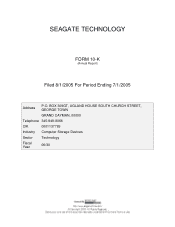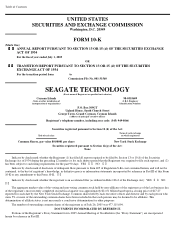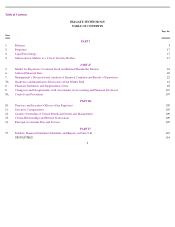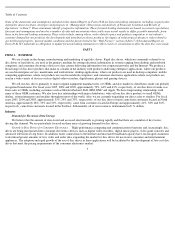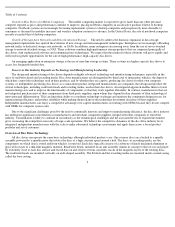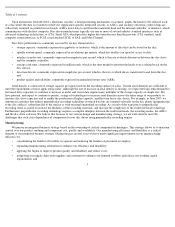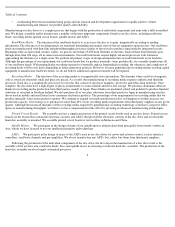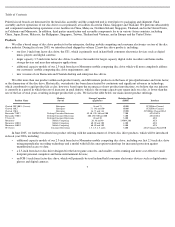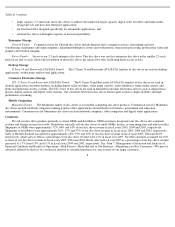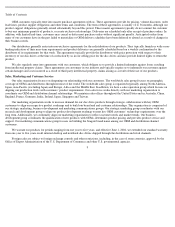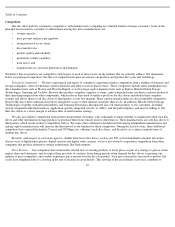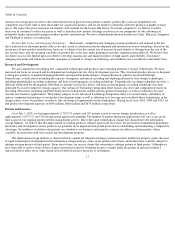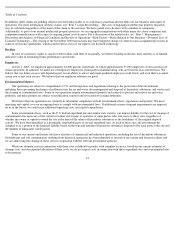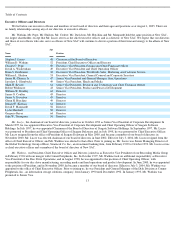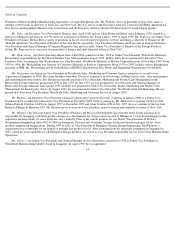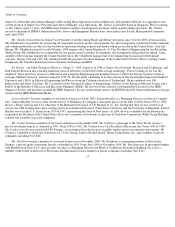Seagate 2004 Annual Report Download - page 7
Download and view the complete annual report
Please find page 7 of the 2004 Seagate annual report below. You can navigate through the pages in the report by either clicking on the pages listed below, or by using the keyword search tool below to find specific information within the annual report.
Table of Contents
Upon instructions from the drive’s electronic circuitry, a head positioning mechanism, or actuator, guides the heads to the selected track
of a disc where the data is recorded or retrieved. Application specific integrated circuits, or ASICs, and ancillary electronic control chips are
collectively mounted on printed circuit boards. ASICs move data to and from the read/write head and the internal controller, or interface, which
communicates with the host computer. Disc drive manufacturers typically use one or more of several industry standard interfaces such as
advanced technology architecture, or ATA, Serial ATA which provides higher data transfer rates than the previous ATA standard, small
computer system interface, or SCSI, serial attached SCSI, or SAS, and Fibre Channel.
Disc drive performance is commonly assessed by six key characteristics:
•
storage capacity, commonly expressed in gigabytes or terabytes, which is the amount of data that can be stored on the disc;
•
spindle rotation speed, commonly expressed in revolutions per minute, which has an effect on speed of access to data;
•
interface transfer rate, commonly expressed in megabytes per second, which is the rate at which data moves between the disc drive
and the computer controller;
•
average seek time, commonly expressed in milliseconds, which is the time needed to position the heads over a selected track on the
disc surface,
•
data transfer rate, commonly expressed in megabytes per second, which is the rate at which data is transferred to and from the disc;
and
Areal density is a measure of storage capacity per square inch on the recording surface of a disc. Current areal densities are sufficient to
meet the requirements of most applications today. Although the rate of increase in areal density is slowing, we expect the long-
term demand for
increased drive capacities to continue to increase as audio and visual data require many multiples of the storage capacity of simple text. We
have pursued, and expect to continue to pursue, a range of technologies to increase areal densities across the entire range of our products to
increase disc drive capacities and to enable the production of higher capacity, smaller form factor disc drives. For example, in June 2005, we
announced a product that utilizes perpendicular recording technology in which data bits are oriented vertically on the disc platter (perpendicular
to the disc surface), rather than flat to the surface as with existing longitudinal recording. As a result of the transition to perpendicular
recording, there is a need to increase the thickness of the recording materials, and increase the complexity of the read/write head technology.
Furthermore, perpendicular recording technology requires a complex interplay between the read/write heads, the recording media, the ASICs
and the disc drive software. We believe that because of our vertical design and manufacturing strategy, we are well suited to meet the
challenges that such close dependence of components for our disc drives using perpendicular recording require.
Manufacturing
•
product quality and reliability, commonly expressed in annualized return rates (ARR).
We pursue an integrated business strategy based on the ownership of critical component technologies. This strategy allows us to maintain
control over our product roadmap and component cost, quality and availability. Our manufacturing efficiency and flexibility is a critical
element of our integrated business strategy. During the past several years we have made significant improvements in our manufacturing
efficiency by:
•
consolidating the number of facilities we operate and reducing the number of personnel we employ;
•
expanding manufacturing automation to enhance our efficiency and flexibility;
•
applying Six Sigma to improve product quality and reliability and reduce costs;
5
•
integrating our supply chain with suppliers and customers to enhance our demand visibility and reduce our working capital
requirements; and

